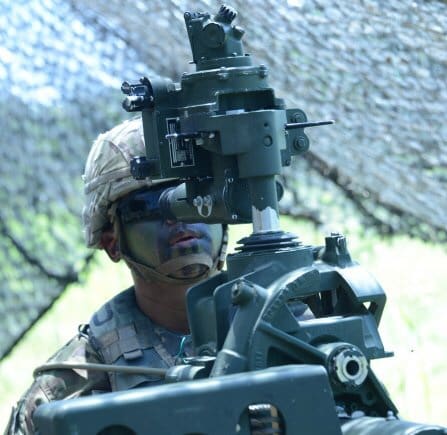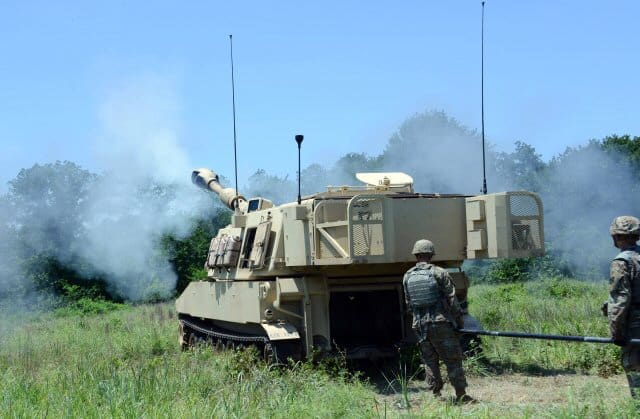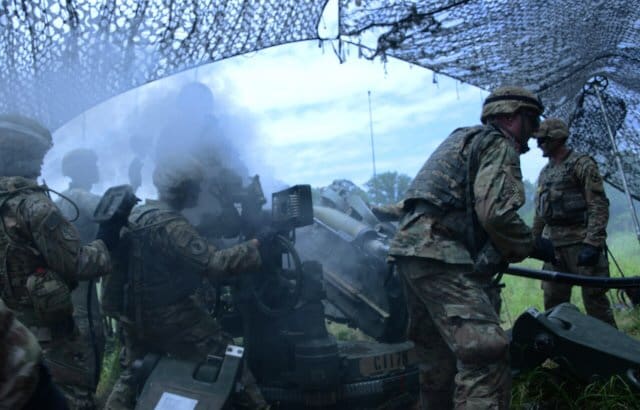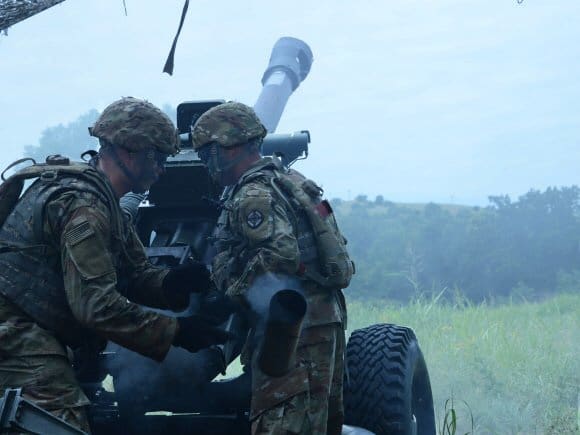FORT SILL, Okla. — With the growing threat of cyberattacks, the U.S. Army Field Artillery School has placed a renewed emphasis on learning manual methods of fire direction and gunnery.

“Bringing back the charts is a big deal,” said Staff Sgt. Chad Payne, an instructor for the 13J fire control specialist course. “If you don’t understand the chart, you won’t actually understand what the automated system is doing for you.”
About a decade ago, the school began reducing its emphasis on teaching manual methods, said Col. Samuel Saine, assistant commandant. That’s because improvements to the Advanced Field Artillery Tactical Data System enabled AFATADS to be used effectively in all situations, he said, and it dramatically sped up the firing process.
Then electronic warfare in Crimea and Ukraine shut systems down there, and at the same time, cyberattacks began disabling automation systems at civilian firms. These attacks “woke some people up,” Saine said.

Over the past year, the Field Artillery School commandant has made it a priority to reinsert manual or degraded operations back into the program of instruction for all courses, Saine said.
BASIC TO BRIGADE COMMAND
The renewed emphasis is not only in advanced individual training for new Soldiers, he said, but also in all of the officer courses from basic up to the pre-command course for colonels.
Now students begin AIT using maps to plot and they learn the math behind firing solutions.
“They’ll do manual operations until we know they fully understand the basics,” Payne said, explaining only then do students move on to the automated system.
This method provides students with a better appreciation of the concepts, he said, enabling them to “hit the ground running” at their first units.

They are also better prepared when electronic warfare takes the AFATADS system offline, he said, and degraded operations are now part of the scenario during AIT field exercises.
When systems go down, Soldiers are now trained on how to transition between the automated and manual methods, confirmed Pvt. Cynthia Antaya, a 13J student at the school.
EW can affect communications, automated systems and access to GPS. So 13J Soldiers break out their charts, pencils, plotting pins and protractors for degraded operations.
“It’s going to be important to know your charts and darts and how to go manual and still be able to continue on with your job, even when everything’s down,” Antaya said.
CANNON CREWS
It’s essential that artillery sections “never sway from our No. 1 task,” Saine emphasized, “and that No. 1 task is to provide uninterrupted fires to the maneuver elements of our Army — the infantry and armor.”
Manual or degraded operations for firing howitzers are actually a 20-level task for the gunner and primarily only 10-level tasks are taught at AIT, said Staff Sgt. Rodrick Stone, an instructor for the 13B cannon crewmember course.

Some instructors, however, still demonstrate manual sighting for the students, Stone said.
“I believe it’s very important that they learn both ways, because in the event that the digital goes down, you have to have a failsafe — a backup plan,” he said.
The Field Artillery School has helped work degraded operations into the program of instruction for the Advanced Leadership Course, Saine said. Since howitzer gunners are by doctrine sergeants, learning how to manually sight howitzers is emphasized in ALC, he said.
With degraded operations, the gunner switches to a panoramic telescopic sight, Stone said. Aiming poles and firing stakes are used. “We already have an additional primary aiming reference that’s set up; he instantly sights in off of that,” Stone said.
Then the traverse hand wheel is spun manually to raise or lower elevation of the howitzer tube, he explained.
“When I was coming in, degraded operations was the only thing that was going on,” Stone said. “There was no digital systems at the time.”
Now the threat of cyber warfare once again makes degraded operations of paramount importance, he said.
“We have more capacity and capability than they do,” Saine said of the enemy, “so they’re going to try to find creative ways to degrade and deny some of our systems.”
BEYOND THE CLASSROOM
The emphasis on degraded operations is not only happening in the schoolhouse, it’s in the field as well, Saine said. Doctrine has been updated and so have performance standards.
Training Circular 3-09.8 for fire support was recently updated with increased performance standards for manual gunnery and degraded operations.
The chief of field artillery emphasizes degraded operations at fires conferences and at quarterly meetings with division artillery commanders, Saine said.
“It’s not just a Fort Sill thing,” Saine said. “He believes very strongly it needs to be informed by the operational force.”
Preparing for EW is not only practical, he said, but it also creates a more well-rounded force.
“What we found along the way is that we actually were increasing the proficiency of our Soldiers and our leaders,” Saine said, “because it helped them understand to a higher degree how everything worked together.”
By Gary Sheftick, Army News Service


Very good news. Ever since the 80’s I’ve always warned to keep handy the hard copy manuals, and the grease pencils and plastic overlays, because one day all this computer stuff is going to get zapped!
Before going to the Dark Side, I was an 11C. Mortarmen could use this as well. Old plotting board etc. and less MBC.
I was a Marine 0861, Fire Support Man from 1998-2005. It makes me feel super old to think that when I went through Ft. Sill everything was manual. I didn’t see an artillery computer until I got to my unit. Even then, it was still faster to sit on the hill with a radio, a compass, a map, and a protractor, and call for fire. It may not be sexy, but it was really gratifying to drop rounds on target, knowing that you made the decisions to get that round on target.
Things had moved really far toward either PFCS or being non-mission capable for a lot of units. Glad to see a return of emphasis on manual gunnery. I hope to see a more solid foundation for young soldiers going to their first artillery battery in terms of understanding spatial geometry concepts, unit movement, and counter battery emphasis. I think that would be a good path forward for the artillery. Ft. Sill needs to stop cranking out soldiers to fill ranks and start teaching real artillery concepts.
Wow….brings back some memories. Wonder if they still make the pins, chart paper, RDF, GFT’s etc..
It was super hard to get those things back in the day.
I was wondering about the GFTs. I remember hearing there was one guy in Lawton, OK that made them, and that was a looong time ago. Also wondering if they’re doing the whole solution manually. Wonder if they still have BUCS?
I think the Army (and to some degree the Marine Corps) got a little too mesmerized by the technology. Sorry for the folks in Crimea and Ukraine, but we stand to learn a lot from those fights as long as decision makers don’t fairy dust away the challenges we could face.
Anyway, good for Ft Sill!
Forgot about BUCS….somewhere there is a retired MGySgt cheering the return of manual gunnery. Probably still did manual met for fun after retiring….
Excellent development. A lot of back-to-basics fieldcraft was in danger of being lost.
I have my guys shoot degraded all the time, I prefer it, and because most of the digital equipment is broken.